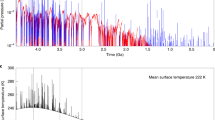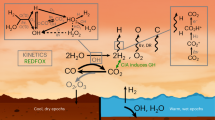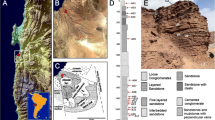Abstract
Terraforming Mars has long captured the imagination but has received surprisingly little rigorous study. Progress in Mars science, climate science, launch capabilities and bioscience motivates a fresh look at Mars terraforming research. Since Sagan’s time, it has been understood that terraforming Mars would involve warming to enable oxygenic photosynthesis by engineered microbes, followed by slow oxygen build-up enabling more complex life. Before we can assess whether warming Mars is worthwhile, relative to the alternative of leaving Mars as a pristine wilderness, we must confront the practical requirements, cost and possible risks. Here we discuss what we know about Mars’s volatile inventories and soil composition, and possible approaches to warm Mars and increase atmospheric O2. New techniques have emerged that could raise Mars’s average global temperature by tens of degrees within a few decades. Research priorities include focusing on understanding fundamental physical, chemical and biological constraints that will shape any future decisions about Mars. Such research would drive advances in Mars exploration, bioscience and climate modelling.
This is a preview of subscription content, access via your institution
Access options
Access Nature and 54 other Nature Portfolio journals
Get Nature+, our best-value online-access subscription
$32.99 / 30 days
cancel any time
Subscribe to this journal
Receive 12 digital issues and online access to articles
$119.00 per year
only $9.92 per issue
Buy this article
- Purchase on SpringerLink
- Instant access to full article PDF
Prices may be subject to local taxes which are calculated during checkout



Similar content being viewed by others
References
Huygens, C. Cosmotheoros, Book 1 (Timothy Childe, 1698).
Rivera-Valentín, E. G., Chevrier, V. F., Soto, A. & Martínez, G. Distribution and habitability of (meta)stable brines on present-day Mars. Nat. Astron. 4, 756–761 (2020).
Paine, T. et al. Pioneering the Space Frontier. The Report of the National Commission on Space (National Commission on Space, 1986).
Sagan, C. & Druyan, A. Pale Blue Dot: A Vision of the Human Future in Space (Ballantine, 1994).
Zubrin, R. M. & Zubrin, M. (eds) Proceedings of the Founding Convention of the Mars Society (parts 1, 2 & 3) (Univelt Publishers, 1998).
Musk, E. Making humans a multi-planetary species. New Space 5, 46–61 (2017).
Grotzinger, J. P. et al. A habitable fluvio-lacustrine environment at Yellowknife Bay, Gale crater, Mars. Science 343, 1242777 (2014).
McKay, C. P. in Exploring the Origin, Extent, and Future of Life: Philosophical, Ethical, and Theological Perspectives (ed. Bertka, C.) 245–260 (Cambridge Astrobiology, 2009).
Marshall, A. Ethics and the extraterrestrial environment. J. Appl. Philos. 10, 227–236 (1993).
Smil, V. Enriching the Earth: Fritz Haber, Carl Bosch, and the Transformation of World Food Production (MIT Press, 2001).
McKay, C. P., Toon, O. B. & Kasting, J. F. Making Mars habitable. Nature 352, 489–496 (1991).
National Academies of Sciences, Engineering, and Medicine. Reflecting Sunlight: Recommendations for Solar Geoengineering Research and Research Governance (National Academies Press, 2021).
Schuerger, A. C. & Nicholson, W. L. Twenty species of hypobarophilic bacteria recovered from diverse soils exhibit growth under simulated Martian conditions at 0.7 kPa. Astrobiology 16, 964–976 (2016).
Arnold, F. H. Innovation by evolution: bringing new chemistry to life (Nobel lecture). Angew. Chem. Int. Ed. 58, 14420–14426 (2019).
Heldmann, J. L. et al. Mission architecture using the SpaceX Starship vehicle to enable a sustained human presence on Mars. New Space 10, 259–273 (2022).
Kuhr, J. The Starship Report (Payload Research, 2024).
Jakosky, B. M. Mars’ atmosphere, volatiles, and climate as the sun heats up over the next 6 billion years. Icarus 410, 115888 (2024).
Wordsworth, R., Kerber, L. & Cockell, C. Enabling Martian habitability with silica aerogel via the solid-state greenhouse effect. Nat. Astron. 3, 898–903 (2019).
Handmer, C. How to terraform Mars for $50bn with solar sails. In Proc. Tenth International Conference on Mars abstr. 3025 (Lunar and Planetary Institute, 2024).
Ansari, S., Kite, E. S., Ramirez, R., Steele, L. & Mohseni, H. Feasibility of keeping Mars warm with nanoparticles. Sci. Adv. 10, eadn4650 (2024).
Averner, M. M. & MacElroy, R. D. On the Habitability of Mars: An Approach to Planetary Ecosynthesis (NASA, 1976).
Goyal, A., Flamholz, A. I., Petroff, A. P. & Murugan, A. Closed ecosystems extract energy through self-organized nutrient cycles. Proc. Natl Acad. Sci. USA 120, e2309387120 (2023).
Stern, J. C. et al. Evidence for indigenous nitrogen in sedimentary and aeolian deposits from the Curiosity rover investigations at Gale Crater, Mars. Proc. Natl Acad. Sci. USA 112, 4245–4250 (2015).
O’Connell‐Cooper, C. D. et al. APXS‐derived chemistry of the Bagnold dune sands: comparisons with Gale Crater soils and the global Martian average. J. Geophys. Res. Planets 122, 2623–2643 (2017).
Sutter, B., McAdam, A. C. & Mahaffy, P. R. in Volatiles in the Martian Crust (eds Filberto, J. & Schwenzer, S. P.) 369–392 (Elsevier, 2019).
Stern, J. C. et al. Organic carbon concentrations in 3.5-billion-year-old lacustrine mudstones of Mars. Proc. Natl Acad. Sci. USA 119, e2201139119 (2022).
Kounaves, S. P. & Oberlin, E. A. in Volatiles in the Martian Crust (eds Filberto, J. & Schwenzer, S. P.) 265–283 (Elsevier, 2019).
Adcock, C. T., Hausrath, E. M. & Forster, P. M. Readily available phosphate from minerals in early aqueous environments on Mars. Nat. Geosci. 6, 824–827 (2013).
Carr, M. H. & Head, J. W. Martian surface/near‐surface water inventory: sources, sinks, and changes with time. Geophys. Res. Lett. 42, 726–732 (2015).
Morgan, G. A. et al. Availability of subsurface water-ice resources in the northern mid-latitudes of Mars. Nat. Astron. 5, 230–236 (2021).
Dundas, C. M. et al. Widespread exposures of extensive clean shallow ice in the midlatitudes of Mars. J. Geophys. Res. Planets 126, e2020JE006617 (2021).
Leshin, L. A. et al. Volatile, isotope, and organic analysis of Martian fines with the Mars Curiosity rover. Science 341, 1238937 (2013).
Golombek, M. et al. SpaceX Starship landing sites on Mars. In Proc. 52nd Lunar and Planetary Science Conference No. 2548, ID 2420 (Lunar and Planetary Institute, 2021).
Schorghofer, N. Mars: quantitative evaluation of crocus melting behind boulders. Astrophys. J. 890, 49 (2020).
Smalyukh, I. I. Thermal management by engineering the alignment of nanocellulose. Adv. Mater. 33, 2001228 (2021).
Marinova, M. M., McKay, C. P. & Hashimoto, H. Radiative-convective model of warming Mars with artificial greenhouse gases. J. Geophys. Res. Planets 110, E03002 (2005).
Richardson, M. I., Toigo, A. D. & Newman, C. E. PlanetWRF: a general purpose, local to global numerical model for planetary atmospheric and climate dynamics. J. Geophys. Res. Planets 112, E09001 (2007).
Haberle, R. M. et al. The Atmosphere and Climate of Mars (Cambridge Univ. Press, 2017).
Bertrand, T., Wilson, R. J., Kahre, M. A., Urata, R. & Kling, A. Simulation of the 2018 global dust storm on Mars using the NASA Ames Mars GCM: a multitracer approach. J. Geophys. Res. Planets 125, e2019JE006122 (2020).
Bierson, C. J. et al. Stratigraphy and evolution of the buried CO2 deposit in the Martian south polar cap. Geophys. Res. Lett. 43, 4172–4179 (2016).
Madeleine, J. B. et al. Recent ice ages on Mars: the role of radiatively active clouds and cloud microphysics. Geophys. Res. Lett. 41, 4873–4879 (2014).
Streeter, P. M., Lewis, S. R., Patel, M. R., Holmes, J. A. & Kass, D. M. Surface warming during the 2018/Mars Year 34 global dust storm. Geophys. Res. Lett. 47, e2019GL083936 (2020).
Wordsworth, R. D., Kerber, L., Pierrehumbert, R. T., Forget, F. & Head, J. W. Comparison of ‘warm and wet’ and ‘cold and icy’ scenarios for early Mars in a 3‐D climate model. J. Geophys. Res. Planets 120, 1201–1219 (2015).
Ramirez, R. M. & Craddock, R. A. The geological and climatological case for a warmer and wetter early Mars. Nat. Geosci. 11, 230–237 (2018).
Green, J. L. et al. Interdisciplinary Research in Terraforming Mars: State of the Profession and Programmatics White Paper No. 488 (American Astronomical Society, 2021).
Fauchez, T. J. et al. TRAPPIST-1 Habitable Atmosphere Intercomparison (THAI): motivations and protocol version 1.0. Geosci. Model Dev. 13, 707–716 (2020).
MacMartin, D. G. & Kravitz, B. The engineering of climate engineering. Annu. Rev. Control Robot. Auton. Syst. 2, 445–467 (2019).
Graham, J. M. The biological terraforming of Mars: planetary ecosynthesis as ecological succession on a global scale. Astrobiology 4, 168–195 (2004).
Cycil, L. M. et al. Investigating the growth of algae under low atmospheric pressures for potential food and oxygen production on Mars. Front. Microbiol. 12, 733244 (2021).
Davila, A. F., Willson, D., Coates, J. D. & McKay, C. P. Perchlorate on Mars: a chemical hazard and a resource for humans. Int. J. Astrobiol. 12, 321–325 (2013).
Lynch, K. L. et al. Evidence for biotic perchlorate reduction in naturally perchlorate-rich sediments of Pilot Valley Basin, Utah. Astrobiology 19, 629–641 (2019).
Breezee, J., Cady, N. & Staley, J. T. Subfreezing growth of the sea ice bacterium ‘Psychromonas ingrahamii’. Microb. Ecol. 47, 300–304 (2004).
Walker, V. K., Palmer, G. R. & Voordouw, G. Freeze–thaw tolerance and clues to the winter survival of a soil community. Appl. Environ. Microbiol. 72, 1784–1792 (2006).
Cockell, C. S. & Raven, J. A. Zones of photosynthetic potential on Mars and the early Earth. Icarus 169, 300–310 (2004).
Diaz, B. & Schulze-Makuch, D. Microbial survival rates of Escherichia coli and Deinococcus radiodurans under low temperature, low pressure, and UV-irradiation conditions, and their relevance to possible Martian life. Astrobiology 6, 332–347 (2006).
Cockell, C. S. et al. Space station biomining experiment demonstrates rare earth element extraction in microgravity and Mars gravity. Nat. Commun. 11, 5523 (2020).
Menezes, A. A., Cumbers, J., Hogan, J. A. & Arkin, A. P. Towards synthetic biological approaches to resource utilization on space missions. J. R. Soc. Interface 12, 20140715 (2015).
National Research Council, Space Studies Board, Space Engineering Board & Committee on Precursor Measurements. Necessary to Support Human Operations on the Surface of Mars Safe on Mars: Precursor Measurements Necessary to Support Human Operations on the Martian Surface (National Academies Press, 2002).
DeBenedictis, E. et al. Polyextremophile engineering: a review of organisms that push the limits of life. Front. Microbiol. 15, 1341701 (2024).
Shean, D. E. Candidate ice-rich material within equatorial craters on Mars. Geophys. Res. Lett. 37, L24202 (2010).
Nangle, S. N. et al. The case for biotech on Mars. Nat. Biotechnol. 38, 401–407 (2020).
Stern, A. et al. Final Report of the NASA Planetary Protection Independent Review Board (National Aeronautics and Space Administration, 2019).
McGarey, P. et al. Development of a loop antenna deployment system for TEM-based subsurface Mars water detection. In Proc. 2022 IEEE Aerospace Conference 1–11 (IEEE, 2022).
McKay, C. in Encountering Life in the Universe (eds Impey, C. et al.) 158–166 (Univ. Arizona Press, 2013).
Schwieterman, E. W., Reinhard, C. T., Olson, S. L., Harman, C. E. & Lyons, T. W. A limited habitable zone for complex life. Astrophys. J. 878, 19 (2019).
West, W., Atwater, H. A. & Kubiak, C. Addressing the Mars ISRU challenge: production of oxygen and fuel from CO2 using sunlight (Keck Institute for Space Studies, 2018).
Wordsworth, R. & Cockell, C. Self-sustaining living habitats in extraterrestrial environments. Astrobiology 4, 1187–1195 (2024).
Lenton, T. M. & Lovelock, J. E. Daisyworld revisited: quantifying biological effects on planetary self-regulation. Tellus B Chem. Phys. Meteorol. 53, 288–305 (2001).
Fischer, W. W., Hemp, J. & Johnson, J. E. Evolution of oxygenic photosynthesis. Annu. Rev. Earth Planet. Sci. 44, 647–683 (2016).
Knoll, A. H. in Fundamentals of Geobiology (eds Knoll, A. H. et al.) 297–314 (Wiley-Blackwell, 2012).
Jakosky, B. M. & Edwards, C. S. Inventory of CO2 available for terraforming Mars. Nat. Astron. 2, 634–639 (2018).
Buhler, P. B. & Piqueux, S. Obliquity‐driven CO2 exchange between Mars’ atmosphere, regolith, and polar cap. J. Geophys. Res. Planets 126, e2020JE006759 (2021).
Tutolo, B. M. et al. Carbonates identified by the Curiosity rover indicate a carbon cycle operated on ancient Mars. Science 388, 292–297 (2025).
Turner, F. W. Life on Mars: Cultivating a planet—and ourselves. Harper’s Magazine 279, 33–40 (1990).
Banfield, D. Mars Science Goals, Objectives, Investigations, and Priorities: 2020 Version (Mars Exploration Program Analysis Group, 2020).
Smith, I. B. et al. The Holy Grail: a road map for unlocking the climate record stored within Mars’ polar layered deposits. Planet. Space Sci. 184, 104841 (2020).
Dickson, J. L. et al. Gullies on Mars could have formed by melting of water ice during periods of high obliquity. Science 380, 1363–1367 (2023).
Hsu, D. C., Ford, E. B., Ragozzine, D. & Ashby, K. Occurrence rates of planets orbiting FGK stars: combining Kepler DR25, Gaia DR2, and Bayesian inference. Astron. J. 158, 109 (2019).
Wright, J. T. et al. The case for technosignatures: why they may be abundant, long-lived, highly detectable, and unambiguous. Astrophys. J. Lett. 927, L30 (2022).
Paulino-Lima, I. G. et al. Extremely high UV-C radiation resistant microorganisms from desert environments with different manganese concentrations. J. Photochem. Photobiol. B 163, 327–336 (2016).
Heinz, J. et al. A new record for microbial perchlorate tolerance: fungal growth in NaClO4 brines and its implications for putative life on Mars. Life 10, 53 (2020).
Kelly, L. C., Cockell, C. S., Thorsteinsson, T., Marteinsson, V. & Stevenson, J. Pioneer microbial communities of the Fimmvörðuháls lava flow, Eyjafjallajökull, Iceland. Microb. Ecol. 68, 504–518 (2014).
Acknowledgements
We thank The Astera Institute for their support of a workshop. We thank all of the workshop attendees for creating a vibrant brainstorming environment. We thank D. Zhou for the creation of Fig. 2. We thank P. Kemeny and M. Hecht for informal comments.
Author information
Authors and Affiliations
Contributions
E.S.K. and E.A.D. wrote the paper. All authors discussed the topics in the paper, contributed to the writing and commented on the evolving drafts.
Corresponding author
Ethics declarations
Competing interests
The authors declare no competing interests.
Peer review
Peer review information
Nature Astronomy thanks Michael Mischna and the other, anonymous, reviewer(s) for their contribution to the peer review of this work.
Additional information
Publisher’s note Springer Nature remains neutral with regard to jurisdictional claims in published maps and institutional affiliations.
Rights and permissions
Springer Nature or its licensor (e.g. a society or other partner) holds exclusive rights to this article under a publishing agreement with the author(s) or other rightsholder(s); author self-archiving of the accepted manuscript version of this article is solely governed by the terms of such publishing agreement and applicable law.
About this article
Cite this article
DeBenedictis, E.A., Kite, E.S., Wordsworth, R.D. et al. The case for Mars terraforming research. Nat Astron 9, 634–639 (2025). https://doi.org/10.1038/s41550-025-02548-0
Received:
Accepted:
Published:
Issue date:
DOI: https://doi.org/10.1038/s41550-025-02548-0



